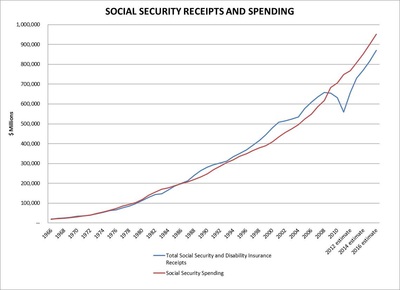Depending on the web site you visit and how it is calculated, at current rates of tax receipts and disbursements, social security will be out of money somewhere between 2030-2040.
From ssa.goc, "The cost of Social Security disability benefits in constant dollars has increased over time, though not consistently.1 Benefit costs grew rapidly during the 1970s and peaked in 1978. A decline in those costs occurred in the early 1980s as the result of changes in program administration that reduced the number of applications and awards as well as the number of disabled-worker beneficiaries. By the late 1980s, benefit costs had begun to increase again, and they continue to rise. The largest increase in cost is among disabled-worker beneficiaries, who accounted for nearly $65 billion of the total $77 billion in 2003 Chart 5).Much of the increase in costs for Social Security disability benefits is due to increases in the number of beneficiaries. Since 1990, the number of disabled-worker beneficiaries has increased 84 percent; disabled widow(er)s, 105 percent; and disabled adult children, 24 percent. "
Looking at the charts below, you can glean the following: There are clusters where Social Security Disability Payments are higher
While the coal mining region of the Appalachian mountain’s (Chart 2 from left) has a score of counties with more than ten percent of the adult population qualifying for disability payments from Social Security (coal mining is one of the most dangerous jobs in the US), in other counties, only one to two percent of residents qualify as disabled.
Rural areas are more dependent on disability benefits than are metropolitan areas. Nationally, 4.6 percent of adults received disability benefits through Social Security. In rural America, 7.6 percent of adults receive these payments. In counties with small cities (between 10,000 and 50,000), 6.5 percent of adults qualify. In metropolitan counties, however, the disability rate among adults is 4.2 percent in 2009.
I'll attribute this, in part, to education, or lack thereof (chart 5 from left). There is a relationship between lack of education and SS disability payments in some area's and in other area's, most notably the Texas/Mexico area, little correlation.
What is noticeable, is that the % on disability flat-lined during the Reagan administration. The reason is simple, he implemented terms that made it more difficult to get on disability. A large part of this increase, I believe, is fraud. Chart 7 can give an indication that this is happening, and some research I've conducted surprises me of the abuse not only in the SS system but also other retirement systems. This is something that adversely affects us all and is easy money for the individuals perpetuating this fraud. What is need is more rigorous screening and follow up by the administration in addition to more whistle blowers; only then will this upward trend be reversed.







 RSS Feed
RSS Feed
